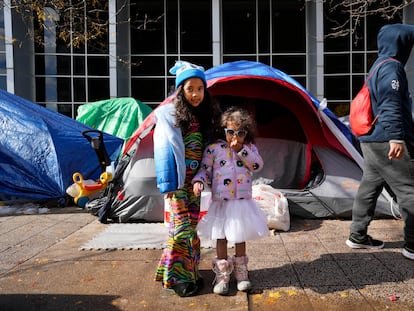Chicago struggles to cope with mass influx of migrants sent from Texas
With more than 40,000 people arriving in the capital of Illinois since the end of August 2022, the city’s reception services have been pushed to breaking point
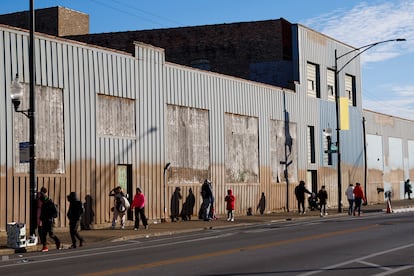

Antonio Contreras does not know what has happened in the last year and a half in the city that is now his home. Nor does he know of the dramas that have taken place in the industrial warehouse where he has been sleeping with his family and a thousand other migrants for two months. Sitting at the doors of the largest migrant shelter in Chicago, where he sells drinks and cookies informally to make money, he can only think about his own odyssey, so similar to that of so many Venezuelans but at the same time so unique. His journey has something of a happy ending, but its outcome is the beginning of another story in which he is nothing more than a pawn that the Republican governor of Texas moves as he pleases. Since the end of August 2022, Greg Abbott has sent hundreds of thousands of migrants from Texas to some of the supposedly most progressive cities in the country. The message is clear: if you love migrants so much, you take care of them.
No city is prepared to receive such a sudden and disorderly influx of migrants. Chicago, the capital of Illinois, which has 2.6 million residents, has received more than 40,000 migrants, about 2% of its original population. With these numbers, Abbott’s move has achieved its desired result: it has called into question the historic welcoming identity of Chicago, exacerbated existing political tensions in the city, many of them racial, and has forced the local administration to improvise, sometimes poorly, a response for which there is no precedent.
The move has laid bare the partisan war between Republicans and Democrats, and the conflict between state and federal authorities over immigration powers. The crisis — fueled by Abbot’s policies and Chicago’s inability to respond to the situation — has strengthened the idea that immigration is out of control, since not even its defenders how to address the problem.
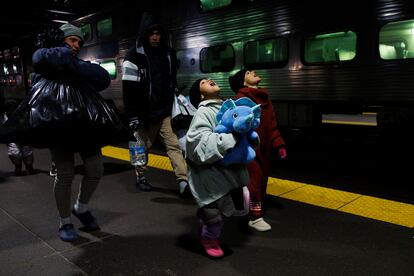
Sanctuary cities in the eye of the storm
The chaos began on August 31, 2022. On that day, a private bus carrying about 50 Latino migrants, mainly Venezuelans, arrived in Chicago unannounced from Texas. When they got off on a random street in the center of the city, they explained that in Texas, once they had been handed over to the authorities after crossing the border, they were asked which city they preferred to go to: New York, Washington — where Texas had already been busing migrants for months — or Chicago. Depending on the answer, based on whether they had a family member or friend there or simply heard something good about the place, they were put on one bus or the other. Then, they were bused more than a thousand miles north, not knowing what would await them.
By the end of September, more than 70 buses had arrived in Chicago with around 9,000 migrants. Abbott made no secret of his policy. “I have directed the Texas Division of Emergency Management to deploy additional buses to send these migrants to self-declared sanctuary cities and provide much-needed relief to our overrun border towns. Until President Biden upholds his constitutional duty to secure America’s southern border, Texas will continue to deploy as many buses as needed to relieve the strain caused by the surge of illegal crossings,” the Texas governor said on September 22, 2022.
Since then — the practice is still part of the Texas immigration policy called “Operation Lone Star”— the focus has fallen mainly on Democrat Joe Biden. The U.S. president has taken note and imposed increasingly restrictive immigration rules, wary of how the crisis may affect the November elections. However, it has been the “sanctuary cities” — which Abbott targets in a bid to expose their alleged moral hypocrisy, since this self-designation implies a commitment to provide shelter and food to migrants and to not collaborate with immigration agencies on deportations — which, without substantial help from the federal government, have faced the problem.
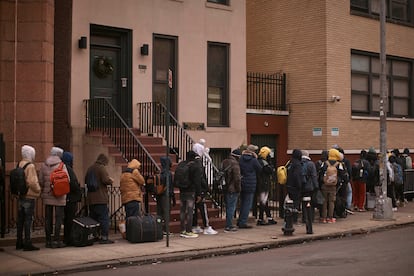
Winter in police stations
From that first day, it has been a matter of improvising solutions on the go. Verónica Román Saldaña, one of the coordinators of the Pilsen Food Pantry, a community organization that fights food insecurity, remembers what it was like. “The local councilor looked for us when the buses started arriving. Our pantry director, Dr. Evelyn Figueroa, had run a homeless shelter during Covid, so she had experience. So they chose her to organize a small, temporary shelter. But what happened is that after a while, the owner of the building, which was borrowed, needed it back.”
Chicago residents took action to help the migrants, just as they did during the pandemic and following the recent arrival of Afghans and Ukrainians. But acts of solidarity only go so far. The buses kept arriving and the idea of municipal shelters run in conjunction with charities did not take off; partly due to logistical difficulties, partly due to legal and bureaucratic obstacles. So a quick and supposedly easy decision was made: the migrants would be relocated to the city’s police stations.
Twelve police stations were set up to house migrants. For many months, some of these facilities had more than 200 people. Migrants slept in sleeping bags in the halls and in plastic tents outside. What’s more, since the stations were work spaces and not homes, there was no access to showers or kitchens. With no clear plan, the first tensions began to arise. The police force — which has a history of scandals and police brutality — began to rebel. Some officers were dedicated to supporting migrants, but many others complained when they were forced to walk on tiptoe to avoid the bodies crammed into their offices. The situation made it impossible for them to fulfill their usual responsibilities. For the migrants, who were grateful that at least they were being given shelter and food, complaints were made about their treatment and conditions. At least one complaint of alleged sexual abuse by an officer was also filed, although the case has not been resolved and is progressing slowly.
By December 2022, winter was just around the corner, which in Chicago means temperatures as low as -22°F (-30°C). Municipal buildings as well as sports centers located in city parks were turned into social and community centers. It seemed like a better solution because they were larger spaces, with good heating and bathrooms with showers. Despite the enormous expense involved in opening these shelters, the challenge of what to do in winter was overcome.
Republicans step up efforts

When spring arrived, many of the migrants from the first months had been relocated to temporary housing or had gone to other parts of the country where they had acquaintances or a job offer, even if it was without papers. But this didn’t make much of a difference, especially with what was to come. As the weather improved, border crossings increased again. Additionally, Chicago elected a new mayor: moderate Democrat Lori Lightfoot was replaced by Brandon Johnson, a progressive who began his political career during a city teachers’ union strike in 2012. Around that time it was also announced that the city would host the Democratic National Convention in 2024. Within weeks, the spotlight became fixed on Chicago. Abbott and the Republican Party stepped up their efforts to portray the city as an example of the dysfunctionality of progressive politicians.
For Johnson, a new strategy was needed to take the migrants out of police stations and municipal buildings in parks, which had stopped fulfilling their original purpose for local communities. This triggered tensions among citizens, who felt like they were being pushed out. But before anything could be planned, a new wave of migrants arrived from Texas.
Chicago’s migrant reception systems, which includes a medical check-up and the practically immediate enrollment of minors in schools, neared breaking point. There was also not enough spaces to accommodate people, who began to sleep and live in bus stations, and soon in Chicago’s two airports, as Texas also began to charter flights of migrants. Migrant arrivals peaked in the summer and early fall of 2023.
The Tent City debacle
Last September, Chicago authorities presented a plan for the following winter: they would build a “Tent City,” camp made up of huge tents with heating and other facilities to house up to 2,000 migrants — a similar plan to the field hospitals built in different cities around the world during the Covid pandemic. The Tent City would be flexible and could be adapted to the city’s changing needs. For the city, it was the perfect solution.
It was the second major blow to the social fabric of Chicago. Initially, the public rejected the idea of housing migrants in tents during the harsh winter on the shores of Lake Michigan; they were unconvinced that the heated tents would be able to provide adequate shelter in such extreme temperatures. Despite this, the project started moving forward in the southern part of the city.
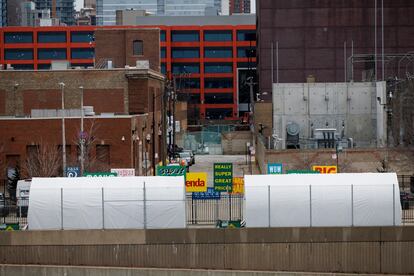
The South Side of Chicago is an area known for its historically high rate of poverty, lack of basic services and homelessness. It is estimated that the vast majority of the 60,000 homeless people in the city live mainly in the south. Chicago’s South Side has also long been predominantly Black. These neighborhoods complained that the city intended to invest to help the newcomers, when it had not invested in the community who had been living there for decades. It was an idea that reverberated through local businesses, the streets, and eventually trickled into municipal offices. Tensions were high.
The crisis was a victory for Abbott, as it showed the friction between local authorities, which had been downplayed by the progressive coalition. Councilor Byron Sigcho-López, an important ally of Mayor Johnson in one of the most Latino locations in the city, is clear on this point. “We have become a target and they want to destroy coalitions like ours to make us an example of what happens when people believe in democracy.” The councilor adds that migration should not be seen as something negative, pointing out that migrants are needed as there are many vacant jobs throughout the country. He explains that the problem is when the arrivals are concentrated in one place and push reception services to the limit.
During the fall, Johnson did his best to keep the Tent City plan alive, but amidst citizen opposition and the results of the soil studies, which found high levels of toxic substances on the site where the camp was to be built, it was announced in early December that the contract was being cancelled. Efforts were then made to relocate the migrants who were in police stations and airports to temporary shelters. By that time, there were around 30 temporary shelters, including converted hotels and industrial warehouses as well as municipal buildings, with an average of 500 occupants in each. By December 17, a few days before the official beginning of winter, the migrants still in police stations and airports had been removed. Victory was claimed — but too soon.
The measles
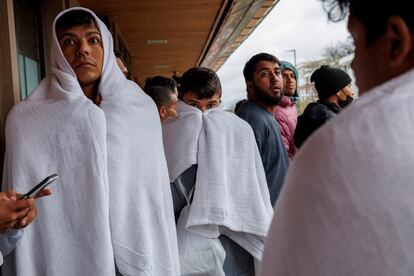
Hundreds of people had been relocated, but the shelters were now completely overcrowded. The weather exacerbated the conditions, keeping everyone inside at all hours. There was a spike in complaints from migrants about the treatment and quality of the food. And as a final consequence, with the lessons of the pandemic about distancing and infections forgotten, there was an outbreak of measles in the largest shelter in the city, a warehouse in the industrial area of the Pilsen neighborhood where about 1,200 people were living.
There were never any exact figures on how many infections there were, in fact for a long time it was denied that it had happened. But the preventable death of a five-year-old child from respiratory complications in March made it impossible to hide the seriousness of the situation. Lopez, in whose district the shelter is located, again sought help from the Pilsen Food Pantry, given its director had also helped coordinate Covid vaccination efforts. In less than a week, they had inoculated all the shelter residents, and the volunteer medical team linked with the organization began making rounds to the rest of the city’s shelters for vaccinations and regular checkups.
It was one of the worst moments for the administration. “Their basic needs were not being met. Nobody is asking for a red carpet or five-star hotels, but at least give them the basics, treat them like human beings. It’s difficult, there is a lot that needs to be done. At least now the city has changed the procedures in the arrival areas: now they are vaccinated immediately and a medical examination is done,” explains Verónica Román Saldaña.
Lessons learned
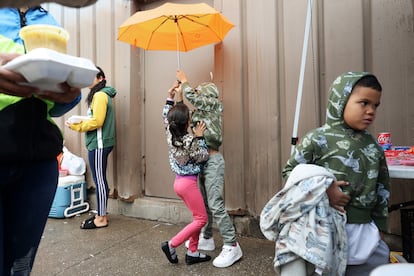
Since then, the management of new arrivals has improved substantially. But challenges remain, and there is reluctance to accept responsibility for past mistakes. The city’s budget is overstretched, even though it has received significant aid from the Illinois state government, and the outlook for the remainder of the year is far from clear.
In order to empty the shelters, the same system as in New York was put in place, limiting lengths of stay to 30 days for single adults or 60 for families. In Chicago, the plan was announced in early March and began to be implemented in April, but exceptions for families with school children, the vast majority, and people with medical conditions, meant that by mid-May only about 700 people had been moved out of the shelters. What’s more, as the weather improves, the flow of migrants from Texas is expected to increase again, although this depends on border crossings, which are currently at relatively low levels for the time of year, mainly due to the cooperative agreement with the Mexican government.
But in Chicago they don’t trust the downward trend. They know that they have the Democratic National Convention at the end of August, and they suspect that Abbott will want to cause more chaos to make it look like the Democrat Party is incapable of governing. Mayor Brandon Johnson believes there is only one quick and effective solution to the situation: granting work permits for migrants. In early April he led a petition with several other mayors of smaller cities addressed to President Biden precisely along these lines.
Walking around the city it is evident that workers are needed: there are plenty of signs and ads looking for bus or train drivers, cooks, cleaners, delivery people, builders, and a long etcetera. There is also no lack of desire to work, to pursue the American dream. Antonio Contreras is the perfect example. Early in the morning he sets up his informal business at the doors of that industrial building that is the largest shelter in the city. He has been selling soft drinks, juices, cookies, chips, gum and candy since he arrived in Chicago three months ago. With his earnings turned into savings, and reconverted into investment, he has bought a car. He doesn’t care if he doesn’t know what goes on in the offices of mayors, governors or presidents. But in his reflections, he sums up the simplicity and complexity of the problem: “I just want to work and raise my family.”
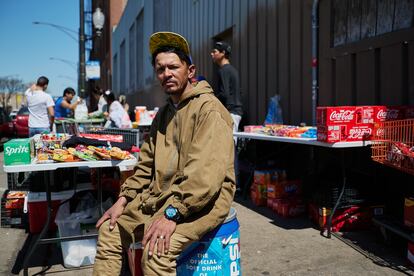
Sign up for our weekly newsletter to get more English-language news coverage from EL PAÍS USA Edition
Tu suscripción se está usando en otro dispositivo
¿Quieres añadir otro usuario a tu suscripción?
Si continúas leyendo en este dispositivo, no se podrá leer en el otro.
FlechaTu suscripción se está usando en otro dispositivo y solo puedes acceder a EL PAÍS desde un dispositivo a la vez.
Si quieres compartir tu cuenta, cambia tu suscripción a la modalidad Premium, así podrás añadir otro usuario. Cada uno accederá con su propia cuenta de email, lo que os permitirá personalizar vuestra experiencia en EL PAÍS.
¿Tienes una suscripción de empresa? Accede aquí para contratar más cuentas.
En el caso de no saber quién está usando tu cuenta, te recomendamos cambiar tu contraseña aquí.
Si decides continuar compartiendo tu cuenta, este mensaje se mostrará en tu dispositivo y en el de la otra persona que está usando tu cuenta de forma indefinida, afectando a tu experiencia de lectura. Puedes consultar aquí los términos y condiciones de la suscripción digital.
More information
Archived In
Últimas noticias
Most viewed
- David King, chemist: ‘There are scientists studying how to cool the planet; nobody should stop these experiments from happening’
- Mexico completes its trade shift with the entry into force of tariffs on China and countries without trade agreements
- Reinhard Genzel, Nobel laureate in physics: ‘One-minute videos will never give you the truth’
- Oona Chaplin: ‘I told James Cameron that I was living in a treehouse and starting a permaculture project with a friend’
- Sinaloa Cartel war is taking its toll on Los Chapitos

